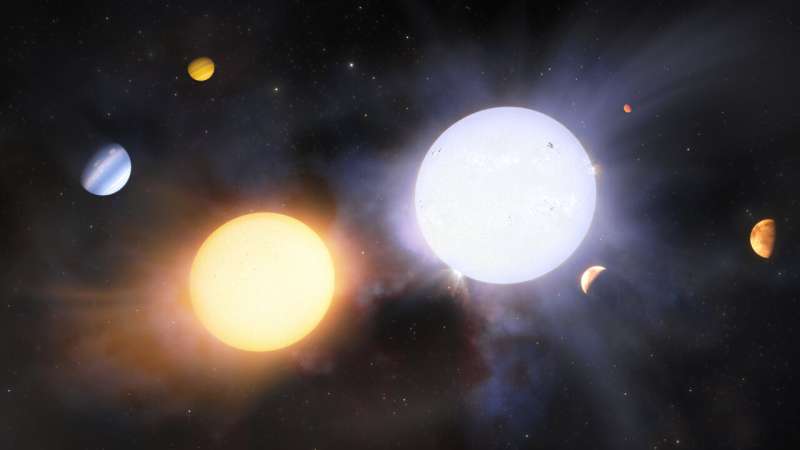This article has been reviewed according to Science X's editorial process and policies. Editors have highlighted the following attributes while ensuring the content's credibility:
fact-checked
peer-reviewed publication
trusted source
proofread
Revealing the origin of unexpected differences in giant binary stars

Using the Gemini South telescope a team of astronomers have confirmed for the first time that differences in binary stars' composition can originate from chemical variations in the cloud of stellar material from which they formed. The results help explain why stars born from the same molecular cloud can possess different chemical composition and host different planetary systems, as well as pose challenges to current stellar and planet formation models.
It is estimated that up to 85% of stars exist in binary star systems, some even in systems with three or more stars. These stellar pairs are born together out of the same molecular cloud from a shared abundance of chemical building blocks, so astronomers would expect to find that they have nearly identical compositions and planetary systems.
However, for many binaries, that isn't the case. While some proposed explanations attribute these dissimilarities to events occurring after the stars evolved, a team of astronomers has confirmed for the first time that they can actually originate from before the stars even began to form.
Led by Carlos Saffe of the Institute of Astronomical, Earth and Space Sciences (ICATE-CONICET) in Argentina, the team used the Gemini South telescope in Chile, one half of the International Gemini Observatory.
With the new, precise Gemini High-Resolution Optical Spectrograph (GHOST), the team studied the different wavelengths of light, or spectra, given off by a pair of giant stars, which revealed significant differences in their chemical makeup.
"GHOST's extremely high-quality spectra offered unprecedented resolution," said Saffe, "allowing us to measure the stars' stellar parameters and chemical abundances with the highest possible precision." These measurements revealed that one star had higher abundances of heavy elements than the other. To disentangle the origin of this discrepancy, the team used a unique approach.
Previous studies have proposed three possible explanations for observed chemical differences between binary stars. Two of them involve processes that would occur well into the stars' evolution: atomic diffusion, or the settling of chemical elements into gradient layers depending on each star's temperature and surface gravity, and the engulfment of a small, rocky planet, which would introduce chemical variations in a star's composition.
The third possible explanation looks back at the beginning of the stars' formation, suggesting that the differences originate from primordial or pre-existing areas of nonuniformity within the molecular cloud. In simpler terms, if the molecular cloud has an uneven distribution of chemical elements, then stars born within that cloud will have different compositions depending on which elements were available at the location where each formed.
So far, studies have concluded that all three explanations are probable; however, these studies focused solely on main sequence binaries. The 'main sequence' is the stage where a star spends most of its existence, and the majority of stars in the universe are main-sequence stars, including our sun.
Instead, Saffe and his team observed a binary consisting of two giant stars. These stars possess extremely deep and strongly turbulent external layers or convective zones. Owing to the properties of these thick convective zones, the team was able to rule out two of the three possible explanations.
The continuous swirling of fluid within the convective zone would make it difficult for the material to settle into layers, meaning giant stars are less sensitive to the effects of atomic diffusion—ruling out the first explanation. The thick external layer also means that a planetary engulfment would not change a star's composition much since the ingested material would rapidly be diluted—ruling out the second explanation.
This leaves primordial inhomogeneities within the molecular cloud as the confirmed explanation. "This is the first time astronomers have been able to confirm that differences between binary stars begin at the earliest stages of their formation," said Saffe.
"Using the precision-measurement capabilities provided by the GHOST instrument, Gemini South is now collecting observations of stars at the end of their lives to reveal the environment in which they were born," says Martin Still, NSF program director for the International Gemini Observatory. "This gives us the ability to explore how the conditions in which stars form can influence their entire existence over millions or billions of years."
Three consequences of this study are of particular significance. First, these results offer an explanation for why astronomers see binary stars with such different planetary systems. "Different planetary systems could mean very different planets—rocky, Earth-like, ice giants, gas giants—that orbit their host stars at different distances and where the potential to support life might be very different," said Saffe.
Second, these results pose a crucial challenge to the concept of chemical tagging—using chemical composition to identify stars that came from the same environment or stellar nursery—by showing that stars with different chemical compositions can still have the same origin.
Finally, observed differences previously attributed to planetary impacts on a star's surface will need to be reviewed, as they might now be seen as having been there from the very beginning of the star's life.
"By showing for the first time that primordial differences really are present and responsible for differences between twin stars, we show that star and planet formation could be more complex than initially thought," said Saffe. "The universe loves diversity."
The study is published in the journal Astronomy & Astrophysics.
More information: C. Saffe et al, Disentangling the origin of chemical differences using GHOST, Astronomy & Astrophysics (2024). DOI: 10.1051/0004-6361/202449263
Journal information: Astronomy & Astrophysics


















